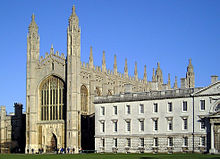King's College Chapel, Cambridge
| King's College Chapel | |
|---|---|

King's College Chapel (partially obscured by the Gibbs' Building), seen from The Backs.
|
|
| 52°12′17″N 0°06′59″E / 52.2048°N 0.1165°ECoordinates: 52°12′17″N 0°06′59″E / 52.2048°N 0.1165°E | |
| Location | Cambridge |
| Country | United Kingdom |
| Denomination | Church of England |
| Previous denomination | Roman Catholic |
| Architecture | |
| Status | Collegiate chapel |
| Functional status | Active |
| Heritage designation | Grade I listed |
| Designated | 26 April 1950 |
| Architect(s) | Disputed |
| Architectural type | Church |
| Style | English Gothic |
| Years built | 1446–1515 |
| Specifications | |
| Length | 289 feet (88 m) |
| Width | Vault: 40 feet (12 m) |
| Height | Interior: 80 feet (24 m) Exterior: 94 feet (29 m) |
| Number of spires | 4 |
| Clergy | |
| Dean | Revd Dr Stephen Cherry |
| Laity | |
| Organist/Director of music | Stephen Cleobury CBE |
| Music group(s) | King's College Choir |
King's College Chapel is the chapel at King's College in the University of Cambridge. It is considered one of the finest examples of late Perpendicular Gothic English architecture. The chapel was built in phases by a succession of kings of England from 1446 to 1515, a period which spanned the Wars of the Roses. The chapel's large stained glass windows were not completed until 1531, and its early Renaissance rood screen was erected in 1532–36. The chapel is an active house of worship, and home of the King's College Choir. The chapel is a significant tourist site and a commonly used symbol of the city of Cambridge.
Henry VI planned a university counterpart to Eton College (whose chapel is very similar, but not on the scale intended by Henry). The King decided the dimensions of the Chapel. The architect of the chapel is disputed: Reginald Ely, who was commissioned in 1444 as the head press mason, was a possible architect; however, Nicholas Close (or Cloos) was recorded as the "surveyor", which has been generally accepted to be synonymous with architect. The first stone of the Chapel was laid, by Henry himself, on the Feast of St James the Apostle, 25 July 1446, the College having been begun in 1441. By the end of the reign of Richard III (1485), despite the Wars of the Roses, five bays had been completed and a timber roof erected. Henry VII visited in 1506, paying for the work to resume and even leaving money so that the work could continue after his death. In 1515, under Henry VIII, the building was complete but the great windows had yet to be made.
...
Wikipedia
